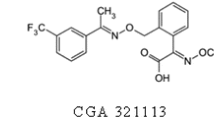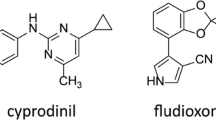Abstract
A combination of imidacloprid and spirotetramat effectively controls sucking pests on grapevines. Residues of these insecticides on grapes were evaluated after treatment with spirotetramat 12 % + imidacloprid 12 % (240 SC) three times at 90 and 180 g a.i. ha−1. The samples were extracted and purified by QuEChERS method and analyzed by high-performance liquid chromatography with a photodiode array detector (imidacloprid) and gas chromatography mass spectrometry (spirotetramat and its metabolite spirotetramat-enol). Satisfactory results were obtained with ranges of 80.6–98.6 % for the recovery, 3.1–10 % for the relative standard deviation range, and 9.8–15.6 % for the uncertainty. The limits of detection and quantification were 0.015 μg mL−1 and 0.05 mg kg−1, respectively. Initial residue concentrations of imidacloprid after the 90 and 180 g a.i. ha−1 treatments were 0.912 (half-life 11 days) and 1.681 mg kg−1 (half-life 12.4 days), respectively. For spirotetramat + spirotetramat-enol, the residue concentrations were 1.337 (half-life 5.6 days) and 2.0 mg kg−1 (half-life 7.6 days) for the 90 and 180 g a.i. ha−1 treatments, respectively. Spirotetramat degraded faster than spirotetramat-enol. After treatment at 90 g a.i. ha−1, the initial residues of both insecticides were within European Union maximum residue limits and a 1-day pre-harvest interval (PHI) was adequate for safe consumption of grapes. After treatment at 180 g a.i. ha−1, the required PHI was 7 day. Therefore, a PHI of 7 day should be used after treatment with imidacloprid and spirotetramat.




Similar content being viewed by others
References
Anastassiades, M., Lehotay, S. J., Stajnbaher, D., & Schenck, F. J. (2003). Fast and easy multiresidue method employing acetonitrile extraction/partitioning and dispersive solid-phase extraction for the determination of pesticide residues in produce. Journal of Association of Official Analytical Chemists, 86, 412–431.
Anonymous. (2008). Spirotetramat, US Environmental Protection Agency, USA, 234, 1779-2018.
Anonymous. (2010). Modification of the existing MRLs for imidacloprid in rice. European Food Safety Authority, EFSA Journal, 8, 1589.
Anonymous. (2014). Reasoned opinion on the modification of the existing MRLs for spirotetramat in olives for oil production, European Food Safety Authority, EFSA Journal, 12, 3739.
D’Arcangelo, M. E. M. (2012). Evaluation of new strategies to control Planococcus ficus (Homoptera Pseudococcidae) on grapevine. Giornate Fitopatologiche 2012, Milano Marittima (RA), 13-16 marzo 2012, pp 211-218.
Baldacchino, F., Mennone, G., Quinto, G. R. & Lacertosa, G. (2012). Efficacy of spirotetramat on mealybug on table grapevine in Apulia. Giornate Fitopatologiche 2012, Milano Marittima (RA), 13-16 marzo 2012, pp 219-222.
Bruck, E., Elbert, A., Fischer, R., Krueger, S., Kühnhold, J., Klueken, A. M., Nauen, R., Niebes, J. F., Reckmann, U., Schnorbach, H. J., Steffens, R., & Waetermeulen, X. (2009). Movento®, an innovative ambimobile insecticide for sucking insect pest control in agriculture: biological profile and field performance. Crop Protection, 28, 838–844.
Buchholz, A., & Nauen, R. (2002). Translocation and translaminar bioavailability of two neonicotinoid insecticides after foliar application to cabbage and cotton. Pest Management Science, 58, 10–16.
Chahil, G. S., Mandal, K., Sahoo, S. K., & Singh, B. (2015). Risk assessment of mixture formulation of spirotetramat and imidacloprid in chilli fruits. Environment Monitoring and Assessment., 187, 4105–4012.
Daane, K. M., Bentley, W. J., Millar, J. G., Walton, V. M., Cooper, M. L., Biscay, P., Yokota, G. Y., Adsule, P. G., Sawant, I. S., & Shikhamany, S. D. (2008). Integrated management of mealybugs in California vineyards. Acta Horticulturae, 785, 235–252.
Dubey, J. K., Sharma, I. D., Patyal, S. K., & Gupta, D. (2006). Translocation and persistence of imidacloprid in apple fruits. Pesticide Research Journal, 18, 82–84.
Fu Castillo, A. A., & Bautista Martínez, N. (2013). Evaluation of a new insecticide for the control of chemical mealybug Planococcus ficus (Signoret) (Hemiptera: Pseudococcidae) in table grapes. Acta Entomológica Chilena, 33, 53–62.
Fu Castillo, A. A., Miranda Blanco, J. L., Osorio Acosta, G., & Martínez Carrillo, J. L. (2004). Chemical control of mealybug Planococcus ficus Signoret (Homoptera:Pseudococcidae) in table grapes. Agricultura Técnica en México, 30, 101–105.
Gaikwad, S. M., Magar, P. N., & Damre, A. S. (2014). Effect of some newer insecticides against okra aphids, Aphis gossypii. International Journal of Plant Protection, 7, 462–464.
González Roberto, H., Christian Volosky, F., & Copefrut, S. A. (2006). Seasonal and management strategies for mealybugs, Pseudococcus spp., in pome fruits, table and wine grapes (Hemiptera: Pseudococcidae). Revista Frutícola, 27, 37–47.
Hoskins, W. M. (1961). Mathematical treatment of loss of pesticide residues. Plant Protection Bulletin (FAO), 9, 163–168.
Iwaya, K., & Kagabu, S. (1998). Biological properties of the chloronicotinyl insecticide imidacloprid: high selectivity and safer use in practice. Review of Toxicology, 2, 121–132.
Jaworska, K., Olszak, R. W., Labanowska, B. H., & Korzeniowski, M. (2012). Efficacy of spirotetramat in the control of pear psylla (Cacopsylla pyri L.) on pear trees in Poland. Journal of Fruit and Ornamental Plant Research, 20, 91–106.
Kencharaddi, A. V., & Balikai, R. A. (2012). Effect of imidacloprid and thiamethoxam treated stored seeds on sucking pests in sunflower. Annals of Plant Protection Science, 20, 107–113.
Kruve, A., Künnapas, A., Herodes, K., & Leito, I. (2008). Matrix effects in pesticide multi-residue analysis by liquid chromatography-mass spectrometry. Journal of Chromatography A, 1187(1–2), 58–66.
Lentza-Rizos, C., & Kokkinaki, K. (2002). Residues of cypermethrin in field-treated grapes and raisins produced after various treatments. Food Additives and Contaminants, 19, 1162–1168.
Lentza-Rizos, C., Avramides, E. J., & Kokkinaki, K. (2006). Residues of azoxystrobin from grapes to raisins. Journal of Agricultural and Food Chemistry, 54, 138–141.
Lozano, F., Kemper, K., & Tundisi, H. (2008). Field development of Movento® Plus for sucking pest insect control in Brazil. Bayer Crop Science Journal, 61, 329–341.
Mohapatra, S., Ahuja, A. K., Deepa, M., Jagadish, G. K., Prakash, G. S., & Kumar, S. (2010). Behaviour of trifloxystrobin and tebuconazole on grapes under semiarid tropical climatic conditions. Pest Management Science, 66, 910–915.
Mohapatra, S., Ahuja, A. K., Sharma, D., Deepa, M., Prakash, G. S., & Kumar, S. (2011). Residue study of imidacloprid in grapes (Vitis vinifera L.) and soi. uality Assurance and Safety of Crops and Foods, 3, 24–27.
Mohapatra, S., Deepa, M., Lekha, S., Nethravathi, B., Radhika, B., & Gourishanker, S. (2012). Residue dynamics of spirotetramat and imidacloprid in/on mango and soil. Bulletin of Environmental Contamination and Toxicology, 89, 862–867.
Morandi Filho, W. J., Grützmacher, A. D., Botton, M., & Bertin, A. (2009). Chemical control of mealybugs Planococcus citri (Risso, 1813) (Hemiptera: Pseudococcidae) in vineyards of different ages. Arquivos do Instituto Biológico (São Paulo), 76, 427–435.
Nauen, R., Reckmann, U., Thomzik, J., & Thielert, W. (2008). Biological profile of spirotetramat (Movento®)—a new two-way systemic (ambimobile) insecticide against sucking pest species. Bayer Crop Science Journal, 61, 245–278.
Pandiselvi, S., Sathiyanarayanan, S., & Ramesh, A. (2010). Determination of spirotetramat and imidacloprid residues in cotton seed, lint, oil and soil by HPLC UV method and their dissipation in cotton plant. Pesticide Research Journal, 22, 168–173.
Salles, L. A. (2002). Os insetos como vetores de patógenos de plantas. Cultivar, 13, 3–6.
SANCO (2011). Method validation and quality control procedures for pesticide residues analysis in food and feed. SANCO/12495/2011.
Sundaram, K. M. S. (1995). Persistence and fate of tebufenozide (RH-5992) insecticide in terrestrial microcosms of a forest environment following spray application of two MIMIC® formulations. Journal of Environmental Science and HealthPart B, 30, 321–358.
Utture, S. C., Banerjee, K., Kolekar, S. S., Dasgupta, S., Oulkar, D. P., Patil, S. H., Wagh, S. S., Adsule, P. G., & Anuse, M. A. (2012). Food safety evaluation of buprofezin, dimethoate and imidacloprid residues in pomegranate. Food Chemistry, 131, 787–795.
Van Waetermeulen, X., Brück, E., Elbert, A., Fischer, R,. Krueger, S., Kühnhold, J., Nauen, R., Niebes, J. F., Reckmann, U., Schnorbach, H. J. & Steffens, R. (2007) Spirotetramat, an innovative fully systemic insecticide for sucking insect pest control in agriculture: biological profile and field performance Proceedings of the XVI International Plant Protection Congress, Glasgow, United Kingdom, 1, pp 60-67.
Van Woerkom, A. H., Acimovic, S. G., Sundin, G. W., Cregg, B. M., Mota-Sanchez, D., Vandervoort, C., & Wise, J. C. (2014). Trunk injection: an alternative technique for pesticide delivery in apples. Crop Protection, 65, 173–185.
Xia, H. L., Wang, Y. G., Wan, H. B., Ma, H. Q., & Chen, Z. M. (1992). Growth dilution by tea plants during the degradation of pesticides in tea plants. Journal of Tea Science, 12, 1–6.
Zhang, K., Wong, J. W., Yang, P., Tech, K., Dibenedetto, A. L., & Lee, N. S. (2011). Multiresidue pesticide analysis of agricultural commodities using acetonitrile salt-out extraction, dispersive solid-phase sample clean-up, and high-performance liquid chromatography-tandem mass spectrometry. Journal of Agriculture and Food Chemistry, 59, 7636–7646.
Acknowledgments
The author thanks the Director, IIHR, Bangalore and Indian Council of Agricultural Research (ICAR), New Delhi, for sponsoring the study.
Author information
Authors and Affiliations
Corresponding author
Rights and permissions
About this article
Cite this article
Mohapatra, S., Kumar, S. & Prakash, G. Residue evaluation of imidacloprid, spirotetramat, and spirotetramat-enol in/on grapes (Vitis vinifera L.) and soil. Environ Monit Assess 187, 632 (2015). https://doi.org/10.1007/s10661-015-4859-x
Received:
Accepted:
Published:
DOI: https://doi.org/10.1007/s10661-015-4859-x




